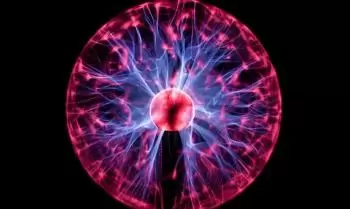
Plasma in physics is an ionized gas, one of the four classical states of aggregation of matter.
This gas is made up of ionized atoms and molecules and contains free electrons and positive and negative ions. In a broader sense, a plasma can be composed of any charged particle.
When the gas is heated to high temperatures, it passes into the plasma. Under these conditions, it is also called the fourth state of aggregation of matter (after solid, liquid, and gas).
The Northern Lights are examples of naturally generated plasma. The solar wind is made up of very high-energy charged particles that form a diffuse plasma. When these particles collide with the atmosphere, they ionize it, and the Northern Lights are produced.
Characteristics of plasma
The main characteristics of plasma are as follows:
-
Neutrality and species present: plasma is made up of equal numbers of positive and negative charges, which cancels the system’s total charge. In such a case, we speak of a neutral or near-neutral plasma.
-
The length of the plasma wave: It also depends on its container’s concave content, which influences its parallelism concerning the x-axis on the earth and affects the length of this wave of the electromagnetic spectrum.
-
Plasma frequency: Just as the Debye length provides a measure of typical lengths in a plasma, the plasma frequency describes its characteristic times.
-
Temperature and thermal speed. In general, the particles of a particular species located at a given point do not have the same speed. On the contrary, they present a distribution that in thermal equilibrium is described by the Maxwell-Boltzmann distribution. The higher the temperature, the greater the velocity dispersion.
-
The plasma parameter: The plasma parameter indicates the average number of particles in a sphere whose radius is the Debye length (Debye sphere).
How is plasma related to electricity?
Since the particles of a gas are mobile, plasma can conduct electrical current. Consequently, plasmas can generate electric and magnetic fields.
A high voltage source provides a strong electrical field that accelerates any free electrons. If this number of electrons acquire sufficient kinetic energy, they will break loose additional free electrons as they collide with neutral gas atoms. The ions and electrons grow exponentially in a runaway process called avalanche breakdown. The breakdown process creates a partially-conducting glowing path through the ionized gas and free electrons - a plasma.
Fluorescent lights or neon signs contain plasma that heats and stirs electricity.
What are the differences between the states of gaseous matter and plasma?
Plasma is often referred to as the fourth state of matter.
Plasma differs from the three least energetic aggregate states of matter, although it is similar to the gas phase in that it does not have a definite shape or volume.
Until now, there is a discussion on the question concerning the nature of the plasma. Some people believe that plasma is a separate state of aggregation and others consider that it is just a hot gas. Most physicists believe that plasma is more than gas.
The plasma in the universe
According to current concepts, the plasma is the most common state of matter in the Universe.
Sun and stars are composed of plasma, and even the space between them is filled with plasma, although very rarefied. The solar corona is the outermost layer of the Sun. It is composed of plasma and extends more than a million kilometers from its origin over the chromosphere.
For example, the planet Jupiter has concentrated in itself practically all the substance of the Solar System, which is in a "non-plasmatic" state (liquid, solid and gaseous). In this case, the mass of Jupiter is only about 0.1% of the mass of the solar system, and the volume is even less - only 10-15%.
The smallest dust particles that fill outer space and carry a specific electrical charge on themselves can collectively be thought of as a plasma consisting of super-heavy charged ions.


